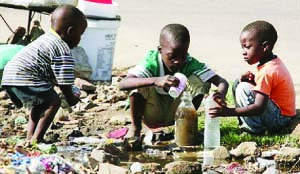By JOWIT SALUSEKI –
CHOLERA outbreak has always caused a huge burden anywhere it occurs in the world and Zambia is no exception, especially with the?onset of the rainy season.
The disease was first identified in 1905 in the Far East with the first cholera outbreak occurring in the Celebes in 1937.
According to the World Health Organisation (WHO), Cholera spread very widely and has affected about 98 countries since 1961.
In the same year (1961) the infection had spread to Indonesia, Philippines, Hong Kong, Malaysia, Burma, Thailand, India and the old Soviet Union.
In 1970, it spread to the Middle East, the Mediterranean and Africa where highest mortality and morbidity rates occur.
The first outbreak of cholera in Zambia was recorded between 1978-1979 with Lusaka recording the first outbreak in 1990.
Dr Dorothy Chanda, a lecturer in the Community Health Nursing at the Department of Nursing Sciences of the school of Medicine, University?of Zambia tells Times Health news that Cholera is a highly infectious, acute diarrhoeal disease with sudden onset, causing profuse rice –water diarrhoea and vomiting which leads to rapid dehydration.
“Cholera is caused by the vibrio cholera micro –organism which is a gramme negative bacilli shaped like a comma. There are about sixty sero-?groups of vibrio cholera which can either be vibrio cholerae O, group 1 or vibrio cholerae 01 sero group,” says Dr Chanda.
Dr Chanda explains that cholera can be spread from an infected person who is a carrier or from someone who is recovering from the disease.
Anecdotal reports also exist of mortuary workers or relatives that contracted the disease while attending to the dead body of their relative who died from cholera.?Indirect spread of cholera can occur through the faecal –oral route which occurs when people drink infected water or eat infected food items.
According to Dr Chanda, in infants, bottle –feeding could be a significant risk factor while washing fruits in contaminated water is also another source of infection.
“Cholera can also be spread through uncontrolled settlements because of poor environmental sanitation with haphazard refuse disposal in the?absence of dust bins, irregular refuse collection by the city councils due to lack of equipment and inadequate maintenance of the refuse vehicle,” explains Dr Chanda.
She says cholera occurs in uncontrolled settlements due to improper citing of pit latrines and use of unprotected wells, especially those lavatories that are built on higher ground than the wells.
“This facilitates drainage of infected faecal matter into the unprotected wells commonly found in compounds with uncontrolled water sources , where shallow wells are used for domestic needs,” she explains.
Dr Chanda further adds that high poverty levels may lead to scavenging in refuse heaps especially by the mentally –unstable people.
She notes that in some communities people opt to wash their dishes in stagnant pools of water despite the rehabilitation of safe tap water citing their inability to pay for the piped water supply.
The medical expert says signs and symptoms of cholera could be high temperature, passage of watery rice –stool and sudden vomiting.
“Adults may not have high temperature while children generally have temperature with cholera. The patient passes a lot of painless watery diarrhea and on set of sudden vomiting which leads to dehydration, weakness , shock and collapse of the patient,” says Dr Chanda.
She outlines that cholera control measures include prophylaxis treatment in areas where the disease is endemic.
This involves the treatment of an entire community with antibiotics , referred to as mass chemoprophylaxis.
However, the medical expert explains that there are a number of reasons for not recommending mass chemoprophylaxis during cholera outbreaks.
Some of the reasons are that the modalities involved in the distribution of the drugs to the entire community are very cumbersome.
Dr Chanda says the cholera can be combated through quarantine and travel restrictions which are ways of mitigating against the spread and transportation of the disease.
Other measures of fighting the spread of cholera includes promotion of food safety, provision of safe water, restrictions of public gatherings, community health education messages, treatment of septic tanks in most of the houses in the Site and Service areas and good personal hygiene.







